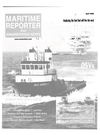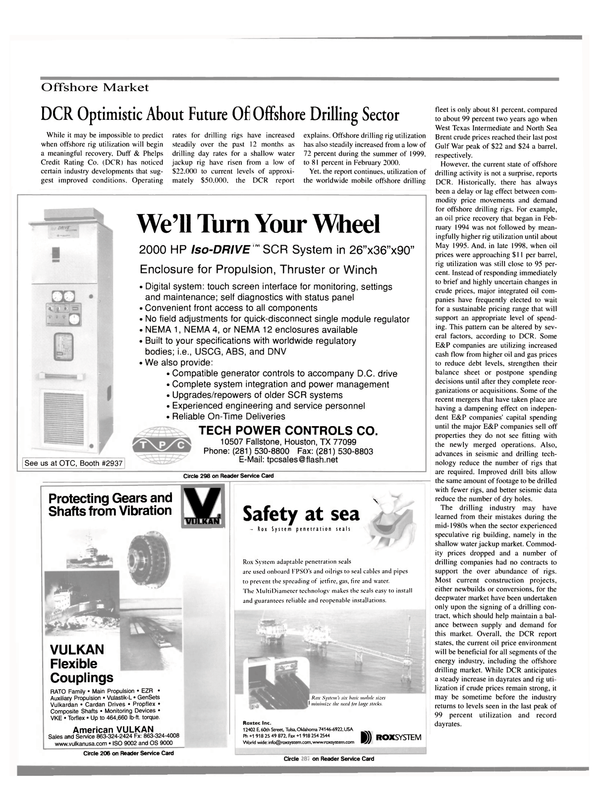
DCR Optimistic About Future Of Offshore Drilling Sector
While it may be impossible to predict when offshore rig utilization will begin a meaningful recovery. Duff & Phelps Credit Rating Co. (DCR) has noticed certain industry developments that suggest improved conditions. Operating rates for drilling rigs have increased steadily over the past 12 months as drilling day rates for a shallow water jackup rig have risen from a low of $22,000 to current levels of approximately $50,000, the DCR report explains. Offshore drilling rig utilization has also steadily increased from a low of 72 percent during the summer of 1999, to 81 percent in February 2000.
Yet. the report continues, utilization of the worldwide mobile offshore drilling fleet is only about 81 percent, compared to about 99 percent two years ago when West Texas Intermediate and North Sea Brent crude prices reached their last post Gulf War peak of $22 and $24 a barrel, respectively.
However, the current state of offshore drilling activity is not a surprise, reports DCR. Historically, there has always been a delay or lag effect between commodity price movements and demand for offshore drilling rigs. For example, an oil price recovery that began in February 1994 was not followed by meaningfully higher rig utilization until about May 1995. And. in late 1998, when oil prices were approaching $11 per barrel, rig utilization was still close to 95 percent.
Instead of responding immediately to brief and highly uncertain changes in crude prices, major integrated oil companies have frequently elected to wait for a sustainable pricing range that will support an appropriate level of spending.
This pattern can be altered by several factors, according to DCR. Some E&P companies are utilizing increased cash flow from higher oil and gas prices to reduce debt levels, strengthen their balance sheet or postpone spending decisions until after they complete reorganizations or acquisitions. Some of the recent mergers that have taken place are having a dampening effect on independent E&P companies' capital spending until the major E&P companies sell off properties they do not see fitting with the newly merged operations. Also, advances in seismic and drilling technology reduce the number of rigs that are required. Improved drill bits allow the same amount of footage to be drilled with fewer rigs, and better seismic data reduce the number of dry holes.
The drilling industry may have learned from their mistakes during the mid-1980s when the sector experienced speculative rig building, namely in the shallow water jackup market. Commodity prices dropped and a number of drilling companies had no contracts to support the over abundance of rigs.
Most current construction projects, either newbuilds or conversions, for the deepwater market have been undertaken only upon the signing of a drilling contract, which should help maintain a balance between supply and demand for this market. Overall, the DCR report states, the current oil price environment will be beneficial for all segments of the energy industry, including the offshore drilling market. While DCR anticipates a steady increase in dayrates and rig utilization if crude prices remain strong, it may be sometime before the industry returns to levels seen in the last peak of 99 percent utilization and record dayrates.
Read DCR Optimistic About Future Of Offshore Drilling Sector in Pdf, Flash or Html5 edition of April 2000 Maritime Reporter
Other stories from April 2000 issue
Content
- Corsaire 13000 Embodies Integrated, Advanced Propulsion System page: 48D
- Jotun: Greening the trade in crude page: 8
- Financing Sources for U.S. Government Programs page: 14
- Deltamarin And Almaco Join Together page: 18
- ASRY Reports Prosperous 1999 page: 18
- A New View page: 20
- The Smokeless Solution Is Coming Over The Horizon page: 22
- Strategic Value Adding Purchasing page: 28
- DCR Optimistic About Future Of Offshore Drilling Sector page: 34
- Offshore Industry Leaders Invest Heavily In Safety Programs page: 36
- Electronic Engines Power New OSV Breed page: 40
- Angola And Canada Provide Projects For Smit Pioneer page: 40
- Rig Repowered At Houston Ship Repair page: 41
- Charting The World Electronically page: 44
- Reality Checked page: 45
- NoFire Technologies Helps Ships Meet SOLAS page: 48
- Is Diesel-Electric Propulsion the System for You? page: 50
- Drew Marine, MAN B&W Launch Redesigned Fuel Mill page: 52
- Austal Breaks 24-Hour Record page: 53
- PropExpert V. 4.2 Released page: 53
- GE To Supply Gas Turbines For IHI page: 54
- Jabsco Offers Oil Change Kit page: 54
- Calling All Mariners page: 56
- MTN, BT Hook-Up Cruise Ships To Cell Phone Network page: 59
- Norwegian Manufacturers Maintain Edge page: 60
- Leica Extends Its Influence In DGPS Arena page: 69
- ViaSat Ups Phase Two page: 69
- Encouraging best practice onboard using video and interactive media page: 73
- Blount Completes Dinner Vessel page: 74
- ACCL Offers New Chicago-Based Cruises page: 78
- Boatracs To Exclusively Distribute MarStar page: 78
- DNV Cleans Up With Celebrity's Millennium page: 79
- Transas Unveils GMDSS Simulator page: 85


